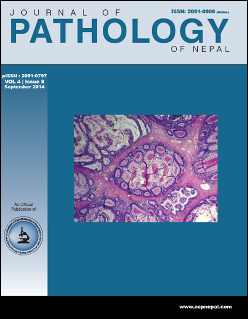Correlation of FNAC and histopathology in diagnosis of salivary gland lesions
DOI:
https://doi.org/10.3126/jpn.v4i8.11593Keywords:
Accuracy, FNAC, Salivary gland, Sensitivity, SpecificityAbstract
Background: Value of fine needle aspiration cytology in preoperative diagnosis of salivary gland lumps has been established in various studies. This study aims to calculate sensitivity, specificity accuracy of FNAC, correlate FNAC findings with histopathology and find out reasons for common diagnostic pitfalls in FNAC.
Materials and methods: This study was performed in 67 patients that presented with salivary gland lumps at Department of pathology, Tribhuvan University Teaching Hospital, Institute of medicine, Kathmandu, Nepal from January 2009 to June 2010. FNAC was performed and was correlated with histopathological diagnosis to judge the sensitivity, specificity and accuracy of FNAC.
Results: Out of 36 cases there was cyto-histological correlation in 28 cases. Pleomorphic adenoma was the most frequent lesion in this study. Parotid gland was the most common site affected by salivary gland lesions. The sensitivity, specificity and accuracy for non-neoplastic lesions was 100%, 89.28%, 91.67%, for benign neoplasms was 100%, 86.95%, 91.67% and for malignant neoplasms was 57.14%, 100%, 83.33% respectively.
Conclusion: FNAC is a useful tool in preoperative diagnosis of salivary gland lesions and can be crucial for the management of the patient. Aspiration and reporting of salivary gland lesions demands a competent pathologist who considers all the possible diagnostic pitfalls in mind.
DOI: http://dx.doi.org/10.3126/jpn.v4i8.11593
Journal of Pathology of Nepal; Vol.4,No. 8 (2014) 654-657
Downloads
Downloads
Published
How to Cite
Issue
Section
License
This license enables reusers to distribute, remix, adapt, and build upon the material in any medium or format, so long as attribution is given to the creator. The license allows for commercial use.




